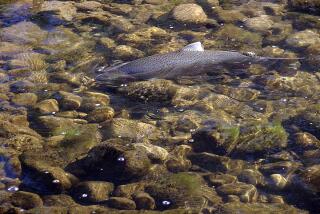Deep in the ocean, the world’s first known warm-blooded fish
Scientists have found the first known example of a fish with warm blood.
The large circular fish is called an opah, or sometimes a moonfish, and researchers have determined that it can keep its internal temperature 5 degrees Celsius warmer than its environment.
“We were shocked,” said Heidi Dewar, a fisheries research biologist at the National Oceanic and Atmospheric Administration who worked on the study published Thursday in Science. “How often do you get to find something that no other fish has? It is a once-in-a-lifetime opportunity.”
There are other fish in the sea capable of elevating the temperature of specific parts of their bodies. For example, some families of tuna and sharks are able to warm their aerobic swimming muscles. Billfish, including sailfish and marlin, are able to warm their eye and brain region.
However, until now, no fish had ever been discovered that can warm its entire body.
The opah spends most of its time hundreds of feet beneath the ocean surface where the water is cold and little light penetrates. Previous research suggested that even at these depths it was able to warm the areas around its mouth and brain. But scientists weren’t sure how until a few years ago when NOAA gill specialist Nicholas Wegner got some opah gills into the lab.
“He was just poking around like nerdy scientists do, and he found this amazing structure,” Dewar said.
What Wegner found was a thick web of blood vessels located right near the opah’s gills called a retia mirabilia, or “wonderful nets.” These nets of blood vessels allow for what is called a counter-current heat exchange.
Because the veins and arteries are all intertwined, warm blood from the fish’s body core comes in close contact with cold blood that has just passed through the gills. Through that contact heat transfers from the warm blood to the cold, warming it up.
Retia mirabilia had been seen in other fish that can heat up certain parts of their bodies, but in the opah this heat exchange occurs right at the gills, keeping warm all the blood that circulates through the fish’s body.
Now you may be wondering how the opah is generating heat in the first place. Unlike most deep-sea fish that wag their tails to move around, the opah flaps its pectoral fins to swim, and it turns out it is flapping those fins almost constantly. The metabolic activity creates heat, which is then transferred to the blood.
“It is the perfect system,” Dewar said. “But none of us would have ever dreamed any of it up.”
Being warm-blooded is an advantage for the opah because it helps the animal see better, think better and respond more quickly when it is chasing fast-moving prey like squid, its preferred food.
Dewar said that the research team was now trying to figure out whether any of the opah’s closest relatives have similar structures, especially those that live in higher latitudes where the water is even colder.
Science rules! Follow me @DeborahNetburn and “like” Los Angeles Times Science & Health on Facebook.







